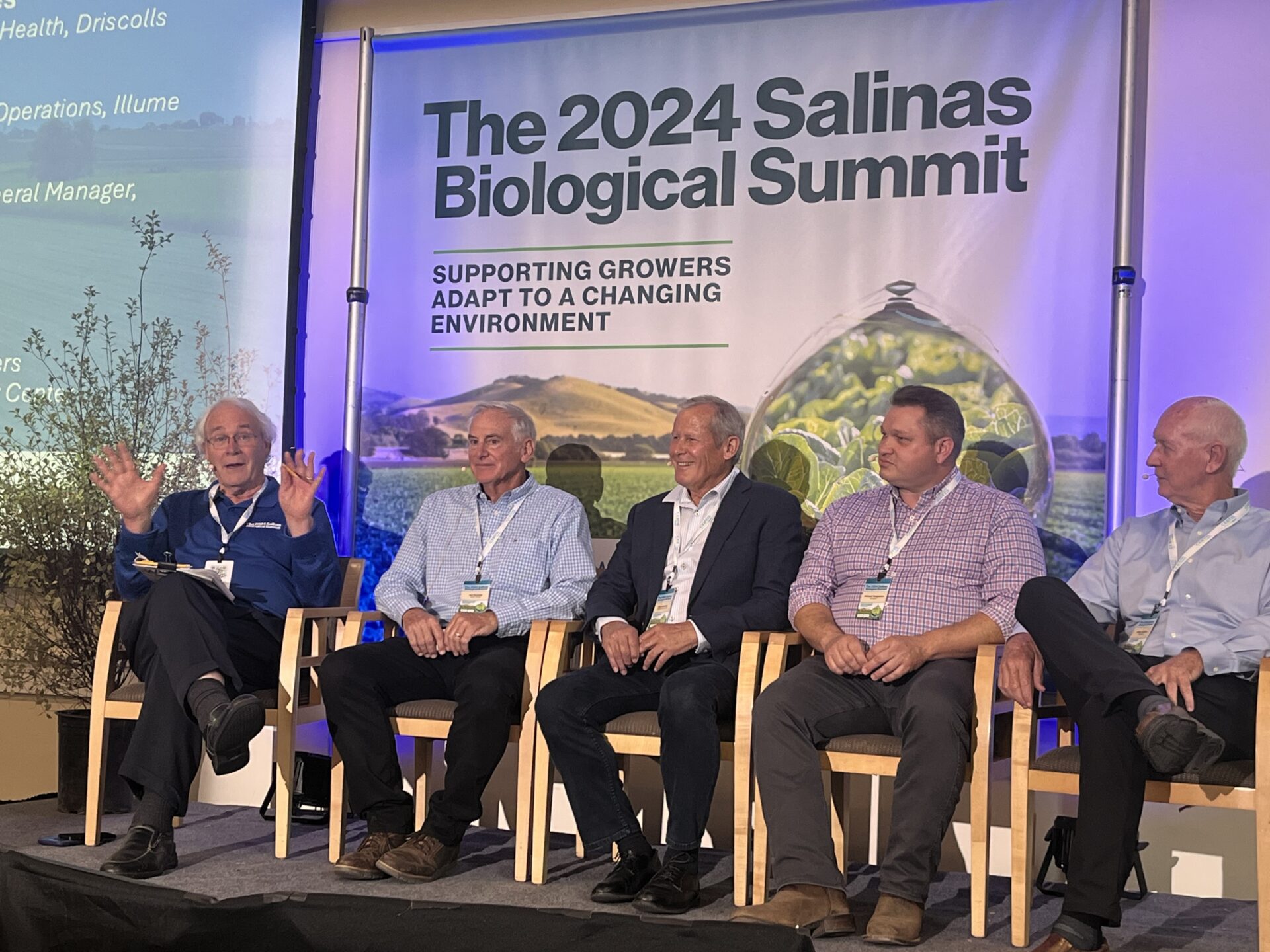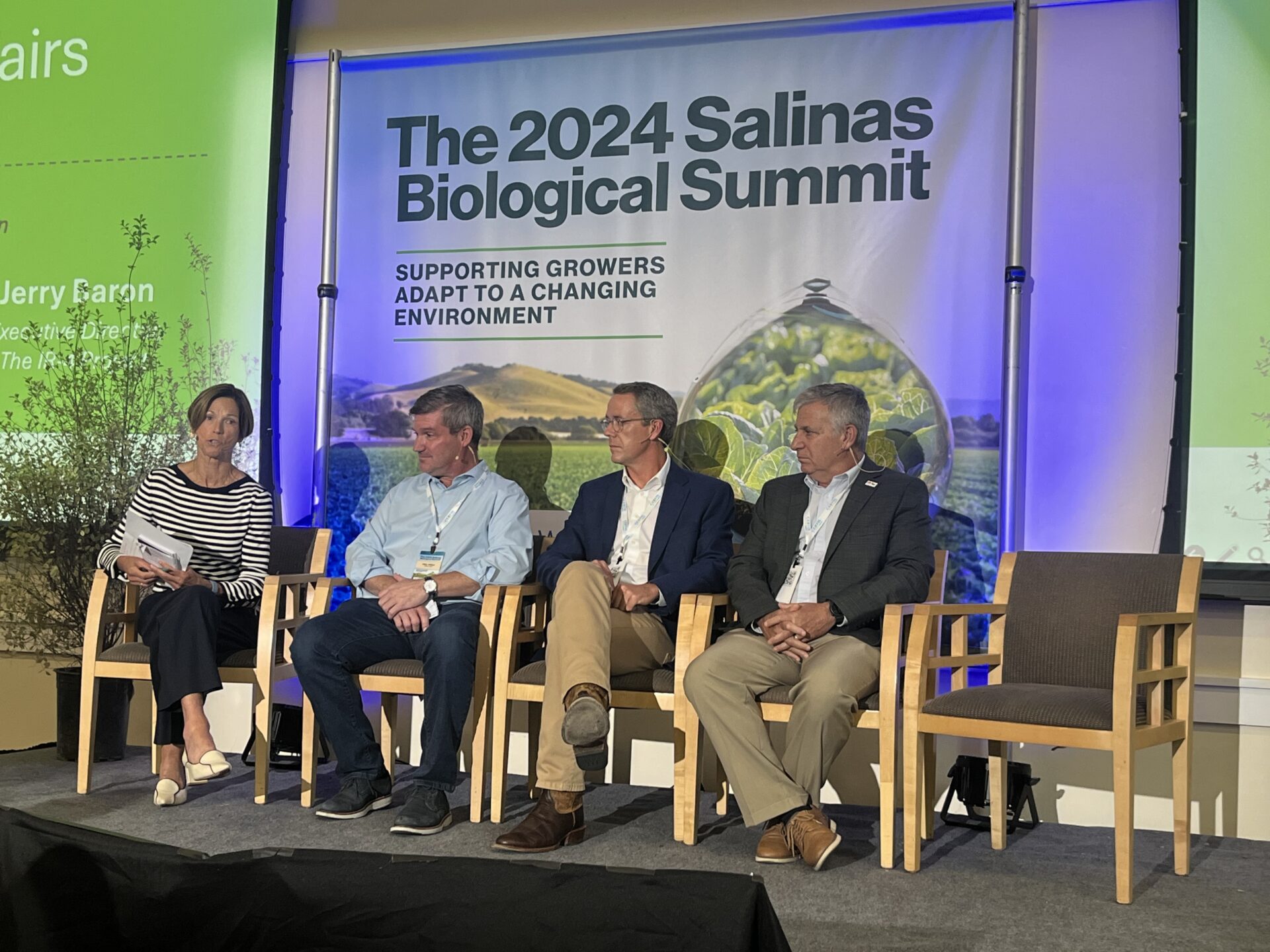When it comes to advancing both the technology and adoption rates of biological-based products in agriculture, “no one sector can do it alone,” said California Department of Food and Agriculture Secretary Karen Ross last week at the 2024 Salinas Biological Summit.
Co-presented by Western Growers Association and New Zealand-based agrifoodtech consultancy Wharf42, the two-day event gathered startups, regulators, investors, agrifood corporates and others to discuss the current state of ag biologicals and where the industry goes from here.
Some of the topics on discussion were old hat, like the ongoing need to provide actual value to farmers and ways investors can avoid funding “snake oil.” Other conversations, such as integrating biologicals with precision ag and AI technologies, were new.
Secretary Ross welcomed Salinas Biological Summit attendees with a message that’s been on the discussion table for years but continues to evolve as the industry changes: “Think about a systems approach: the right tool at the right place and the right amount at the right time.”
Highlights from various talks and panels throughout the event suggest the many ways in which stakeholders are trying — or need to try — to make this systems approach a reality for ag biologicals.
‘Colliding forces’ are an opportunity for biologicals
Western Growers president and CEO Dave Puglia kicked off the summit with what he said was “not the most uplifting message.”
“The fact of the matter is, we’re losing synthetic products at a pretty rapid rate now, and we’ve got to get around that corner and, instead of complaining about that fact, find solutions. That’s what biologicals represent to us: it’s a huge, looming potential set of solutions that we have to realize.”
There are a number of forces driving both the challenge and opportunity here, he suggested. Growers feel the heat from buyers (e.g., major retail food companies), federal and state governments, consumers and others to reduce or eliminate synthetic products.
At the same time, capital is hard to come by right now. “That is a troubling development when we’re looking for more capital to come in and speed the development of biologicals because of those pressure points that are hitting us externally,” Puglia noted.
“The pressure’s on, folks. We’ve gotta start cranking it up.”
On a more uplifting note, he said “those colliding forces have actually helped sharpen our focus here.”

Products have to work for the grower
Of course, “None of this matters if the economics don’t work for the grower,” said Puglia.
Arguably, the main takeaway from the 2024 Salinas Biological Summit was that message, repeated ad infinitum over the course of the two-day event.
“We need to ask ourselves, in terms of what we’re delivering to farmers, How do we slot in seamlessly to what they’re doing today?” Ospraie Ag Science cofounder Carl Casale said during a panel. “How do we make our products easy to use? [How do we] create applications that help us get into what they’re doing versus trying to convince them they will like [the products]?”
Startups and those developing products, he added, must be able to explain what their product does, how it gets used and what new benefits it brings. “If somebody can’t explain to you what you’re buying and how it works, would you really want to buy it?” asked Casale.
“If it doesn’t solve a grower problem, it’s not probably a good investment,” said Mark Trimmer of biologicals research firm Dunham Trimmer during his session.
That said, product developers need to be strategic about when and where they work with growers, particularly on beta testing.
Elliot Kellner, director of commercial innovation at the Donald Danforth Plant Center, used the example of a Danforth partner to illustrate this point.
“They were ready to go to field trials and they were excited, but they couldn’t find a place to do it. I asked if [they] needed contacts from innovation-friendly growers. [They] said, “I don’t want to work with the grower right now, because if I go onto a grower’s farm and the thing doesn’t work, all of his neighbors will know about it and we will be sunk before we started.”
“That’s the thing that people don’t realize about our industry,” added Vonnie Estes, VP of innovation for the International Fresh Produce Association. “If you go out and it’s a flat fail, that grower isn’t going to try it again.”
Kellner suggested “external farms,” such as those from land grant universities, where startups can access space to conduct real field trials without putting their reputation amongst the growers at risk in those early stages.

Biologicals and agtech need each other
Other agriculture technologies have a huge role to play in the adoption of biologicals, as was highlighted throughout the event.
Like synthetics, biologicals need to be applied in the right place, at the right time, in the right amounts. Technologies leveraging automation, AI and robotics could prove very useful here.
John Deere, for example, already has a number of precision ag tools on the market that are reducing the use of synthetics required on the farm.
Speaking during the event Alexey Rostapshov, head of JD Labs & sustainability, said John Deere’s ExactShot system, which “essentially micro doses seeds during planting with fertilizer” is precise enough to cut fertilizer use by 60%; the See & Spray system reduces herbicide application by 50%.
“When you think about expensive new biological solutions, all of a sudden the economics start to be a little bit more palatable when you’re able to be very precise in an application,” he said.
“As you think about impacts of biologicals and and making sure sure [a solution is] going where it needs to go, there’s already technology out there and I think that’s an opportunity to keep figuring out how can that be leveraged for these new new inputs.”

The regulatory landscape needs to evolve
Brazil is a major leader when it comes to building a regulatory framework that enables speedy deployment of biologicals in the field.
“It’s amazing the number of products that they’ve been able to register in a short period of time [due to] policies that have been implemented to enable that to happen,” said Corteva Agriscience’s global biologicals regulatory policy leader Terry Stone.
The rest of the world would be well served to take a page from Brazil’s playbook.
Shannon said the United States Environmental Protection Agency (EPA) currently has 80 new active ingredients pending registration for biopesticides and roughly 20 science reviewers for them.
“On our side, the resource issue is real, and I think if we could get more resources like Brazil has, we probably could improve our efficiency.”
On a separate panel, Danforth Center’s Kellner suggested that new innovations in processes are what’s needed for regulators.
“With the FDA [US Food & Drug Administration], you have emergency-use authorizations for new pharmaceuticals if the company can make a solid case for why they are urgently needed by the public.”
Agriculture, he said, does not have that right now. “Instead, we have to provide longitudinal studies to USDA over the course of years, multiple regular trial cycles to say we know that this product works and it doesn’t harm and we know that it’s good for this.” This makes it extremely difficult to be agile and quick in responding to climate and market pressures, he added.
‘Realism has set in’
In her plenary, Dr. Marrone examined the current place of biologicals on the Gartner Hype Cycle, which measures the maturity of any given tech. Biologicals have, she said, passed the “peak of inflated expectations,” which Gartner defines as a period dotted with a few success stories and “scores of failures.”
“Realism is set into this category,” said Dr. Marrone. Now it is important to show how ag biological products have value, most importantly to the farmers.
“There’s so many exciting technologies, but from surveys that haven’t changed in five years, our most important work is still at the grower level — to educate and show the value of these products.”




